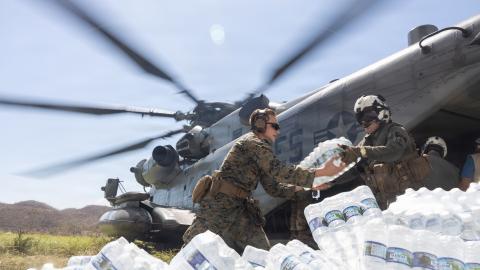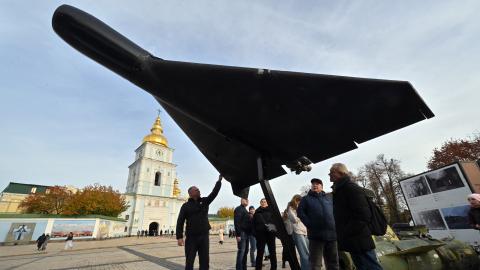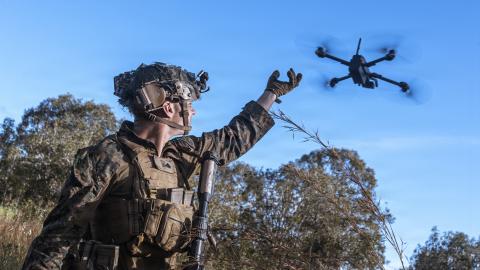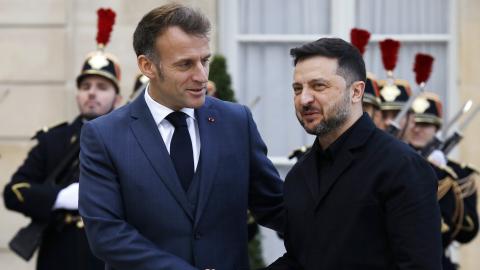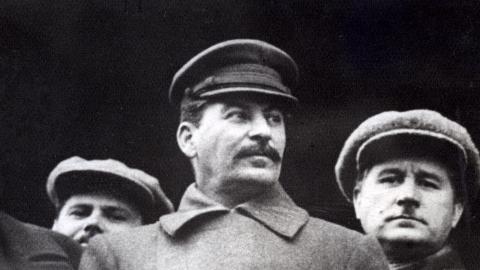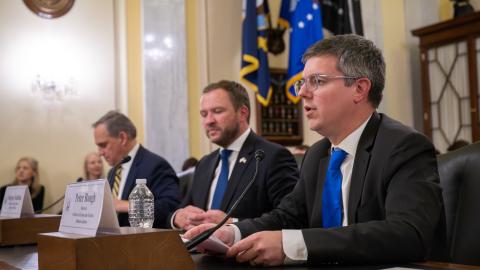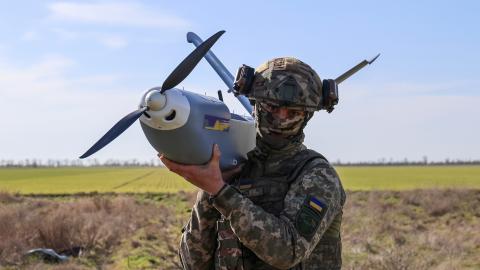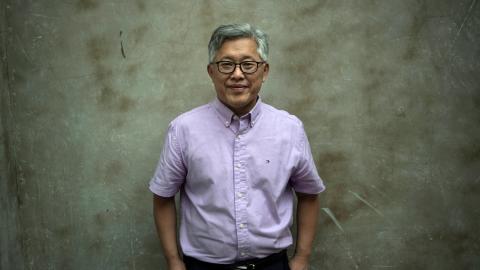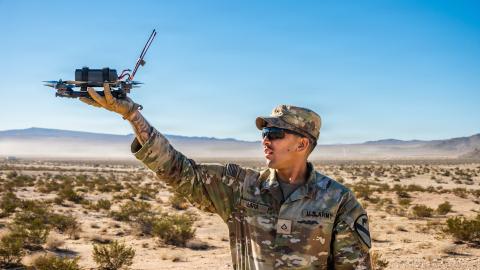
The Future of Army Space and Missile Defense with Lieutenant General Sean A. Gainey
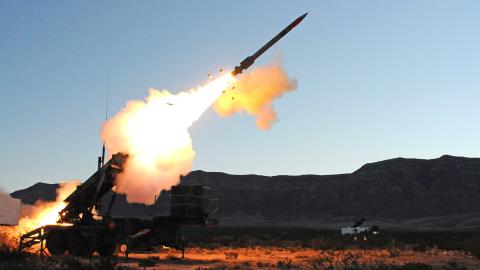

Senior Fellow, Center for Defense Concepts and Technology
Timothy A. Walton is a senior fellow at Hudson Institute, supporting the work of the Center for Defense Concepts and Technology.
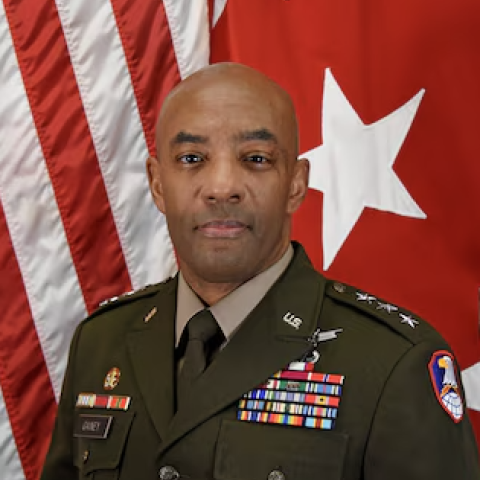
Commander, US Army Space and Missile Defense Command
The United States Army Space and Missile Defense Command (SMDC) develops and operates global space, missile defense, and high-altitude systems. Conflicts in Ukraine and the Middle East have underscored the importance of space and missile defense capabilities, but questions remain regarding the Army’s role and preparedness in performing these missions.
Please join US Army SMDC commander Lieutenant General Sean A. Gainey and Hudson Senior Fellow Timothy A. Walton for a discussion with participants on what role Army forces should play in space operations, how Army air and missile defense forces should modernize, and how SMDC can deepen its engagement in the Pacific.
Breakfast will be served starting at 8:30 a.m.
Event Transcript
This transcription is automatically generated and edited lightly for accuracy. Please excuse any errors.
Timothy A. Walton:
Well, good morning everyone and welcome to the Hudson Institute. I’m Timothy Walton. I’m a senior fellow in Hudson’s Center for Defense Concepts and Technology, and I’m really grateful that all of you have taken the time for what should be, I think, an illuminating conversation with Lieutenant General Sean Gainey, who’s the commander of the US Army’s Space and Missile Defense Command.
Lieutenant General Gainey has had an illustrious career that started in short range air defense, included multiple deployments in support of combat operations in the Middle East, and recently included command of the 94th Army Air Missile Defense Command, the unit responsible for air missile defense in the Indo-Pacific, and was deputy director on the Joint Staff for J8 Force Protection before assuming command of SMDC this January.
General Gainey, thank you very much for coming. And before starting, I think in terms of the heart of some of our questions, I wanted to bring up this map that shows SMDC’s global responsibilities. It’s said that the sun never sets on SMDC, and I wanted to ask if you could start by describing how you view the responsibilities of the command and how you want to maybe accelerate its relevance for the operational missions, and the R&D and testing and evaluation that’s necessary for the department.
Lieutenant General Sean A. Gainey:
Yeah, great, Tim, and appreciate you having me here today. Anytime I get the opportunity to talk about Space and Missile Defense Command, Integrated Air Missile Defense Army Space is always a great day, and hopefully you get to walk away with something you might’ve not have known about the command.
So SMDC, Space and Missile Defense Command is a phenomenal command, a phenomenal team. The command serves as, we serve as the Army component command for NORTHCOM, SPACECOM, and STRATCOM. So just that alone is a Herculean effort, and then you add in the providing training ready forces with our 1st Space Brigade, providing forces directly to US Space Command, and our ability to provide training ready forces through our 100th Missile Defense Brigade. Mitch is responsible for the GBIs in support of NORTHCOM, protecting a homeland against intercontinental ballistic missiles.
And we also, a little known fact is we also own the Army Astronaut Detachment, where we have two astronauts. Well, we have three astronauts. One of the astronauts moved out to command, actually Kwajalein Atoll.
I also serve as the senior commander for Kwajalein and Fort Greely. So as you can see, the breadth and depth of this command across the globe, and the number of assets either doing a space or a missile defense mission set, truly incredible. And I think that map helps illustrate that.
Also, another hat I wear is the Commander of the Joint Force Functional Component Command for Integrated Missile Defense for the Joint Force. So essentially, in that hat, we assist in driving joint integrated air missile defense education training, and we serve as the trans-regional missile defense element under Space Command. So again, a lot of varying, different duties across the command that we’re really excited about.
Timothy A. Walton:
Thanks, general. I wanted to start on the topic of space. Last year the Joint Tactical Ground Station Mission was transferred from the Army to the Space Force. So I wanted to ask you, if you could start by describing some of the roles of the 1st Space Brigade in the Army. And to be frank, why not transfer all these capabilities to the Space Force?
Lieutenant General Sean A. Gainey:
Okay, and thanks for that question, because that’s a question that I’m often asked. Why Army Space, and why do we have Army Space, especially in the growth of the Space Force in other entities in space?
Well, as you can imagine with today’s technology, almost majority of our capability are reliant on space-based assets, and having that ability organically in the Army is not a luxury, it’s critical to have, and from a terrestrial base where all things in space start and end on the ground, the Army has to have that capability to ensure we can operate in a degraded, denied type environment. And those capabilities that are resident inside of our Army Space Forces allow our Army to be able to continue long range precision fires, continue to communicate in a contested environment, and also impact our adversary’s capabilities. So space is critical, and it’s critical to have it inside of our Army.
Actually, we don’t have enough inside of the Army. So if you look at the 1st Space Brigade that’s inside of Space Missile Defense Command, it’s not the only Army capabilities, but it’s the majority of the capabilities and some of the most critical, which is our space control planning teams only reside in our 1st Space Brigade, and that capability really helps drive the space fires of our actual capabilities and systems out there, so those planning team is very critical, and only resident inside of the 1st Space Brigade.
Also, 1st Space Brigade has our space capabilities and our space planners in programs of record, more of a static type capability, but also we’ve introduced a lot of prototyping, leveraging RTDE funding to leverage small form factors inside of a brigade.
So I have the luxury inside of my command of taking S and T work with my tech center. And I forgot to highlight the tech center school earlier, but our tech center works with RTDE, looking at S and T projects that from the gap analysis of our command, and other commands frankly, and look at how can they, from an S and T, work closely with industry to bring that capability to bear in prototyping.
So, we’re able to take, from my center of excellence, a gap analysis, what we require for the current fight and a future fight, work directly with our tech center to do S and T work with the industry to bring those capabilities to our 1st Space Brigade, and our 1st Space Brigade can take it out, test it operationally in an operational setting, get feedback, learn, provide it back to our Army capability managers that are inside of our center of excellence, and then work directly with the PM to improve that capability. So having all that capability, and then being able to leverage the 1st Space Brigade to be able to do that.
Now again, 1st Space Brigade is not the only Army Space capability after we’ve infused space capability inside of our multi-domain task forces. So each multi-domain task force, and there’s going to eventually be five of those, has Army Space capability inside of the multi-domain effects battalion, where they’re fielding more, and more capability to be able to do more in support of the Army that’s located under the COCOMs, the Army Service Component Commands, under to provide those space capabilities directly to the war fighter.
Timothy A. Walton:
That’s really insightful, and I wanted to follow up a little bit by remember a quote that Secretary of the Air Force, Frank Kendall, has encouraged or directed the Space Force, “To focus more on generating terrestrial effects, in addition to maybe on orbit effects.” And it makes me think about what’s an appropriate, in your mind, framework for division of labor maybe, or maybe in some cases, there’s appropriate duplication because we want there to be redundancy in the force, but maybe the Navy and naval forces and Army Forces and Air Forces have their localized generation of space control capabilities and space situational awareness, while the Space Force focuses maybe on more universal level coverage. How are you viewing this evolve, moving forward?
Lieutenant General Sean A. Gainey:
I think you answered it appropriately very well. And that’s really how it’s happening now, the Army elements, because of our relationship with US Space Command, and we have assigned forces to US Space Command, Space Command provides that broader look, but with its assigned forces from the Army and the Space Force, it’s able to optimize the employment. So in some cases, for the Army, yes, we’re able to focus locally with our infusion of capability inside of the multi-domain task force.
So for example, first MDTF supporting United States Army Pacific can provide direct support to that element, while my 1st Space Brigade providing capability as an assigned force to SPACECOM, the SPACECOM commander now has the ability to look globally and leverage our Army Space capabilities, UCOMM, INDOPACOM, and Space Force capabilities, which are similar, same way. And also, the Marines are fielding capability inside of their formations to support more of a localized fight for the Marines, in direct support of their forces.
But the one thing I’m really proud of from the space capabilities is the partnership, that we work so closely together, not only amongst the services, but internationally too. We work very closely with the UK. I have a L and O in the UK right now, working with their space to help them build their space capabilities. We’re looking to pull L and Os inside of our organization. So the divisional labor is wide. But also, if you look across the Joint Force, the Marines come to our schoolhouse, get trained at our schoolhouse, and then eventually, and have served duty on some of our deployed capabilities as they learn and feel their capabilities. So array, some localized and some leveraged globally through, and that’s the goodness of having US Space Command.
Timothy A. Walton:
Thank you. I had another maybe slightly counterintuitive question of dropping from space to high altitude. What we saw last month in the Valiant Shield exercise, the Army was flying some steerable stratospheric balloons. It’s an interesting capability space for the Army. Why has SMDC, I think, led a lot of the R&D in this area?
Lieutenant General Sean A. Gainey:
Yeah, SMDC is actually the proponent for the Army’s high altitude platforms, and you’re probably visually seeing it through some of our smaller balloons, to be able to leverage it. And really the purpose of that is I’ve always been a fan of balloons that can provide over the horizon support in a missile defense perspective. Some of you may remember the JLENS program that was actually a really good capability that could provide over the horizon detection and far control data to our systems.
Well, if you look at platforms and space capabilities, and it is really not so much, but it’s the package that you can put on the platform to allow the commanders to extend their mission command capabilities, to extend their over horizon visualization, and so, doing it with a low cost balloon that you can proliferate is exciting. And with SMDC being a proponent and having the ability to leverage partners like USASOC has been a great partnership, General Braga at USASOC has employed it with working closely with our capability developers, and working with industry to be able to really test it out and find out what’s the best platform we want to leverage and move forward with.
And again, it may not be a balloon in the future, because when I say high altitude platforms, it could be a drone type capability, fixed wing type capability that can loiter for an extended time. So we’re keeping an open aperture as we work with the industry to find out what’s the best capability out there. And then leveraging the multi-domain task force, which actually have a high altitude element inside of their formations, and USASOC to test out what’s the right capability to actually eventually field, as a program of record, or maybe not as a program of record, just field it and dispose of it, and then find something new and keep moving forward in a new paradigm of acquisition.
Timothy A. Walton:
Thank you. And I think it’s a really promising approach, just because it seems like SMDC in many ways is riding on the coattails of the commercial industry. We saw Google’s project, Loon, and then DARPA helped mature that effort for the steerable stratospheric balloons. And then also, in some of the other altitude, pseudo-satellite space, we see Airbus Zephyr programs and there’s that HAPS high altitude pseudo-satellite alliance. So it’s an opportunity, I think, where the army can leverage some of this and then think through what are the appropriate payloads to integrate.
Another area I wanted to pivot to is, I think, near and dear to your heart: air missile defense. Last few years, we’ve seen these enormous salvos of weapons being launched in Ukraine in the Middle East and in many cases being defeated, including some against US forces in the Middle East. What trends are you drawing from this in terms of either changes to tactics, techniques and procedures, or capability development or integration?
Lieutenant General Sean A. Gainey:
Yeah, so over the last three years, I’ve had the opportunity to really look at this problem set in incredible detail, because the last three years, I’ve worked as the director of the Joint Counter-UAS Office, helping the department develop capabilities to defeat drones. But also, on the Army staff, I worked in an area called DAMO-Fires, which has responsibility for all Army integrated air missile defense systems. And in my current role as the SMDC commander, yes, we have this strategic missile defense forces with the GBIs, but also, part of my role is to serve as the integrator for Integrated Air Missile Defense to the Chief of Staff of the Army. And in that role, I work very closely with all the stakeholders and integrated air missile, plus being a senior air defense officer in the Army, it’s an inherent role that I take on and I really want to drive forward.
Looking at the problem, and again, I started looking at the problem closely in CENTCOM because our soldiers were under fire in CENTCOM, mainly from Group III UAS, but also rockets. And also, we had some TBMs launched at a certain point in time also. But watching the threat, and one of the things that I was able to put my arms around from that threat, was the ability to launch complex elbows from tactical ballistic missiles to cruise missiles to UASs, and all at the same time in 360 degrees. And so as we were looking at this problem set, and in that role, I got a chance to move around and talk to a lot of people. And I knew from seeing it in CENTCOM that we as an army, and actually as a DOD, had to move towards a single C-II integrated system that could provide a 360 capability, and be able to do that without leveraging multi-operators that aren’t connected.
And that’s how we were, because that’s how our systems were designed. You have a short-range system designed to do that. You have a counter-cruise missile system and a TBM system. And as the army, we’ve been leveraging heavily on Patriot to do all of that minus the counter-UAS. We’ve finally developed some capability where it can handle the US. And so inadvertently, we put a significant strain on our army forces by leveraging solely on the Patriot system. So now, looking at the lessons learned of complex multi-salvo type of attacks, the lesson that was learned is what I highlighted. All systems integrated into a common C-II with the ability to leverage the appropriate factor with the appropriate sensor.
What we are doing in the army through our modernization is we’re taking what’s called our integrated battle command system, which is known as IBCS, so I’ll refer to that moving forward, just so you understand. And that’s a fire control C-II system, which has the ability to integrate the traditional Patriot components, the radar, the launchers, but also integrate the counter cruise missile capability launchers with the Sentinel radar, and eventually even the counter UAS capability where the operator has the ability from his EOC to be able to leverage the sense fire control data from that element and then assign that target to the appropriate effector, and employ that in a 360-degree manner. Again, not a luxury. Essential that we move that way based off of what we’re seeing.
To close this, and really to validate our approach moving forward, I was talking to the 10th AAMDC when I was visiting in Germany, and they sent a couple of colonels to Ukraine. And when they talked to the commander on the ground during one of the attacks, his comment was, “The attacks came. Different types, heavy mass, and it came from everywhere,” and they had challenges responding to it because of that. And so obviously we have to modernize, transform how we do business, and we’re doing that in contact, which makes it even tough. But as we move forward to our defensive Guam system, you’ll start seeing this capability employed regionally and then eventually globally as we move forward with our modernization program.
Timothy A. Walton:
Thank you. I wanted to ask a follow-up on how do we do this faster. In particular, I think, we’ve observed in Ukraine for instance the importance of passive defense measures, camouflage concealment, deception, passive and active decoys, and multi-spectral camouflage on the real air defense artillery units and five to 10 times as many decoys for the others. You can play the shell game. Yet, to be frank, when we look at the Army air defense artillery portfolio like the LTAMs, lower tier air missile defense system, and placement displacement times seem to be pretty long. Some of the IFPIC type systems in direct fire protection capability units seem to be stationary as opposed to mobile. From your perch at SMDC, how are you trying to push this shift to a more fluid and resilient air defense design that obviously requires more personnel at some level, so you could play that shell game, but it also likely requires new requirements.
Lieutenant General Sean A. Gainey:
And you bring up a great point, and I’ll address the first piece on how do you move faster. The experience I was able to gain from working in the Joint Counter-UAS office, where you have no choice but to move fast because, again, soldiers in contact, you don’t have the luxury of waiting for a program of record through the acquisition timeline. You have to lay out requirements, get prototypes, and what we were able to do in the Joint Counter-UAS Office and they’re doing now is take prototypes off the assembly line, get them to our warfighter. Now, knowing they may not be perfect, but ensuring their safety for use and have the ability to do what they’re designed to do, and then get them in the hands of our soldiers. And what we continually find is our soldiers is they iterate on the capability, they’re able to provide that feedback faster to the Army capability managers and then to the actual industry, and we’re able to rapidly evolve that capability.
This is exactly what we did with the Coyote interceptor. Essentially, prior to the CENTCOM piece, when I took over, we didn’t have a low-cost, high-volume of Counter-UAS-specific interceptors. And we got the original out, and we got it out there as a block one type effector. And within a couple of years, we were up to block three in the performance. We just saw it consistently improve over time. Also, directed energy. We’ve been talking about directed energy and lasers for a long time. Well, we got them into theater and we’re using them in theater and we’re learning from them. And the first system we put out in theater compared to the system we have now is vastly improved from sustainment capability. And we’re now working with wattage beam control, how to make it even better, but starts with getting it into theater.
And that’s what we’re going to do with the Integrated Air Missile Defense portfolio. We’re going to get it out in the field rapidly and then start iterating and continue to improve that capability. In the IFPIC counter-cruise missile capability, we’ve already got those prototypes to 151 88th Battalion, and they’re going to start getting that capability out, exercising it, and from your point of being able to move. The way we’re moving with our capability in integrated air missile defense and IBCS is essentially our cruise missile capability is going to be a launcher. So that launcher can be march-ordered and moved rapidly and the disbursement of it, because it would all tie in and then leverage a sensor that’s locally or a sensor in the location that’s going to move to, to get after some of the movement and ability not to be static in one location and move around.
And your last point, yes, you bring up a great point. We cannot defeat this threat with active defense alone. In missile defense, there’s three pillars of missile defense: active defense, attack ops, and passive ops. You talked a lot about the passive ops, whether it’s decoy, camouflaging. That is a significant portion of what we need to do holistically in missile defense. And you see some of our partners leveraging a lot, some of them putting up netting to be able to mitigate some of the drone warfare, leveraging decoys to add difficulty into the calculus of our adversary. But there has to be a holistic approach in the missile defeat process from supply chain all the way through to active defense. And that’s one of the roles as the Commander of JFCC IMD that I’ve taken on working closely with the SPACECOM commander in his role, in his UCP task as trans-regional missile defense, on how do we stop just focusing and admiring the active defense portion of this fight and start moving more towards the left-of-launch, the holistic missile defeat?
We’ve done that in the counter-UAS fight. It started as active defense where the Joint Counter-UAS Office and the service were working, but the Secretary of Defense said, “No, we need to look holistically. SOCOM, you’re going to pick up the left-of-launch piece.” And so now you have SOCOM focused on all the way up to launch and then the active defense piece with the services after launch, because the amount of drones, cruise missile, TBMs, are just incredible. And when you saw some of the last launches and the numbers that were put out there, it’s going to take a holistic layered approach to be able to defeat those type of threats moving forward in the future.
Timothy A. Walton:
Thank you. I want to open up the floor to questions from our participants, so please start to consider any questions you may have. Before doing so though, I wanted to ask you a final question on the Marshall Islands. So this March, the United States renewed its Compact of Free Association with the Republic of the Marshall Islands, the Federated States of Micronesia, and the Republic of Palau. And this seems to offer an opportunity for the Army and Department of Defense more broadly to deepen its commitment to the Marshall Islands and then to, I think, prepare some of these critical facilities for rising sea states. What are your thoughts on how to move forward in the Marshall Islands?
Lieutenant General Sean A. Gainey:
Great. You got me fired up about Integrated Air Missile Defense, and you’ve pivoted quickly on me. I was ready to get more into missile defense, but I’m sure the crowd will-
Timothy A. Walton:
I’m sure there’s going to be a lot of questions on that.
Lieutenant General Sean A. Gainey:
. . . get my excitement but I’m just as passionate about Kwajalein, and the work that the command and our team is doing out there. And the reason Kwajalein is important to Space and Missile Defense Command is the Reagan test site that we have out there and the associated radars that support the test and mission. And STRATCOM is active is a active user of that range because that’s the only range that provides some of the ability to do what some of our customers are able to do with whether testing long range type of capability or some of our sensing capability. So very strategic site. And if you look at history and back in the World War II, American lives were lost fighting for Kwajalein. And so it’s very key terrain inside of the INDOPACOM AOR. And we were happy to see that happen and I was able to talk to the ambassador a couple of weeks ago and it’s great to see the ambassadors on board also.
But Kwajalein Atoll is critical and we as the Army has continued work to do on Kwajalein to continue to improve Kwajalein, to be able to continue to support and do the critical things that we can do and should be doing on Kwajalein. And with the test range and the critical mission of the radars we have on Kwajalein, it’s great to see that everything’s coming together with the president signing the pact and then our ability to continue to support and do what we do in Kwajalein I truly believe is going to pay dividends as we move forward future because we see a lot of opportunities in the INDOPACOM AOR, not just focused on the Reagan test site, but other areas that as we move forward in the future, the command and Endo.
Paycom will leverage moving forward.
Timothy A. Walton:
Thank you, General, I want to open up the floor to questions. I’d ask if you could please identify yourself, your affiliation, and ask a concise question. We’ll start with here on the front, please.
Luke Coffey:
Thank you. Good morning. Luke Coffey, senior fellow here at Hudson. From your perch as the commander of Space and Missile Defense Command, has there been a single surprise from the war in Ukraine for you and missile defense in the future of this capability? And in addition to that shocker, that surprise, has there been a big striking lesson learned on how we need to change the way we do business in this area? Thanks.
Lieutenant General Sean A. Gainey:
Yeah. So I guess I would say I feel very comfortable for my times in the study where nothing really surprised me, but what intrigued me was Ukraine’s ability to innovate low cost innovation. For example, their use of acoustic sensors proliferated across their country to the point now where they’re almost positively identifying drones in distance because of this acoustic and fire teams attached to that acoustic low cost capability that they’ve developed and proliferated. And at a low cost perspective and additive capability because the way they’ve employed this acoustic sensor and as the cat and mouse game of flying drones higher, lower, or fast or slower, they’ve been able to innovate and adapt to have a pretty good capability from the detection standpoint and a low cost defeat.
One of the things, lessons learned, is probably more of the earlier that I highlighted, the ability to be able to disperse our capability 360 and be able to respond to several different threats simultaneously and looking at it holistically because they’re making choices of whether or not to shoot certain because there’s so many, and in leveraging passive capabilities. But also looking at their capabilities, specifically their acoustic technology and their innovation in that area, and finding a way how do we integrate that type of low cost capability into our system?
Just because it’s low cost and some of our stuff is higher cost, we should be able to find ways to work together and augment some of our capabilities with some of that lower cost capability.
Luke Coffey:
Thank you.
Timothy A. Walton:
Question in the back, please.
Mike Atona:
Hey, sir. Good to see you again. Mike Atona. Northrop Grumman. What do you wish IBCS could do that it doesn’t do now for you?
Lieutenant General Sean A. Gainey:
I guess that remains to be seen because my vision of IBCS . . . And again, I’m anticipating that my vision is met with what it can actually do is that IBCS is able to ingest as technology continues to improve from . . . Right now we’re not talking integration of non-kinetic capability, high-powered microwave capability and directed energy capability. But my vision is that as we move forward and as technology areas that can help us get around the cost curve maturate, it’s an easy pull and push integration. So as something is becoming obsolete as a high cost interceptor that we may not need to rely on as much now because of the technology and directed energy, we can rapidly integrate.
My vision would be, and probably the area that I believe we’ll have to work out, doing it rapidly. Not saying, “Okay, here’s a new technology. Now it’s going to take us a year or so to integrate it.” No, we need to rapidly integrate it so we can continue to move in fighting seamlessly without waiting for how do we connect this, how long is it going to take? And my vision is that that’s going to happen and that’s happening. And so as Northrop Grumman, you have the answers to the test now. It’s the rapid integration of capability as it comes on board so it can be a truly plug and play type of system.
Timothy A. Walton:
I have another question here at the front, please.
Lauren Fish:
Hi sir. Thanks for being here. Lauren Fish, L3Harris Technologies. So you’ve talked a little bit about the lessons learned from Ukraine and it’s been very obvious, especially the Army has focused on the CUAS mission in the last one to two years and in the budget cycle there’s a lot of commitment. How are you and maybe your S&T folks thinking about how that translates to INDOPACOM and the more diverse domain environment there, the maritime environment and the extended ranges as you incorporate?
Lieutenant General Sean A. Gainey:
Yeah, so that’s a great question and I always highlight it as it was relatively easy to focus on a syncom AOR because that was a threat. It was in our face. We were able to get stuff out there and innovate in the technology being used and looking at the technology in the INDOPACOM theater and some of the things we’re seeing with hypersonics maneuverable capability. And as you highlighted, the large amount of space to cover.
We believe the leveraging from the army perspective of the IBCS network capability and then as a highlighted then as technology comes on board to eventually get after the more advanced stress and threats, one of the start is the LTAMDS radar integration into . . . That is a vastly improved radar compared to the current radar we have. It’s going to provide a lot more capability.
So as we bring in different interceptors and other types of capability to design it, more of the advanced threat is how we’re going to move forward getting after the INDOPACOM AOR. Now remember, INDOPACOM is a priority theater. That’s why our IBCS-enabled system is going to that location and we’re going to learn a lot, like a highlighter, once we put it in that theater and test it. And we’re already testing it in simulations, exercises against advanced threats. And so we’re already making adjustment, TTPs, additions on how to leverage current capability that we have now and emerging technology to be able to fuse that together in that theater. Thank you.
Timothy A. Walton:
Question in the back, please.
Meredith Rodan:
Hi sir. Meredith Rodan from Janes. I had a question about the mass issue of different projectiles coming in. As you mentioned, it’s heavy mass coming from everywhere. There was a JCO exercise yesterday that had scenarios where there were 40 to 50 drones coming in at once. Is that the high end that you see your COCOM needing to be able to get after or is that the average of 40 to 50 drones or missiles or whatever that you see coming at once?
Lieutenant General Sean A. Gainey:
Yeah, that’s a really good question because one of the areas, and you’re talking of the JCO demo on swarms and the industry’s ability to provide capability against swarms. And that’s one of the probably most significant concerns when it comes to the capability developed not only from a detection perspective, but operator overload from a C2 perspective and then the ability to put steel on target, non-kinetic on target, whatever it takes.
We as the Army have looked at technology like DE and high-powered microwave to assist in the area of large salvos and what we’re talking about, we’re not talking large salvos over a long distance where you can eventually attrit it as it gets there. So when it finally gets to you. We’re looking at salvos that are relatively short range distance that are coming in attempting to overwhelm the operator.
So far as numbers, I really couldn’t tell you because it’s going to vary depending on where you are. It could be raids of six to 10 and in some locations it could be 40. In some locations you’re going to have the adversary looking at how can we mass up to hundreds on target at one time because it’s all a cat and mouse game of how can I overwhelm your defenses and what are you able to do to respond to it? So the numbers I believe will vary. I believe 40 was a good number because if you can address 40 and you’re now starting to build the components of the ability to get after more because 40 . . . and being able to put 40 time on target, synchronize exactly at the same time is something difficult to do. But there’s a lot of work in leveraging technology and leveling our space-based capabilities to be able to do it is happening. So that was a needed demonstration.
Again, we’re already moving towards swarming. Again, the investment we’re putting into high-powered microwave to be able to address a large number at one time at a relatively low cost per shot capability. And so hopefully we’re innovating fast enough in that area. We already have four high-powered microwave prototypes out in an organization and from this demonstration. And essentially that’s our call to industry from an Army DOD perspective. Hey, we need help in this area. Come bring your best technology, best ways you can get after it and let’s go for it. And then if it works, and I haven’t gotten a read out of that, a demonstration yet, but depending on what works and not, then take it and then fund it and get it out rapidly and then start learning in the field on making it better as opposed to just waiting and taking long time. Screw the acquisition process.
Timothy A. Walton:
Question here.
Will Harwood:
Thank you. Will Harwood, I’m just here as a citizen. Just a quick question on the structure and the lanes that you’re swimming in. What is your interface with the DIU and also in terms of looking at all the . . . And also just from your structure, are you looking at this from the perspective of the war fighter? So looking at all these domains, you’re dealing with drones, you’re dealing with space. And is there a way to funnel that information into the DIU and then the Navy does the same thing, the Air Force does the same thing, and then they’re able to have a set of recommendations from a center of excellence that are coming forward and are able to meet those threats? Thank you.
Lieutenant General Sean A. Gainey:
Yeah, that’s a really good question. So if I attack it first from the Joint Counter UAS brain, that was essentially the design for the Joint Counter UAS. And the reason I’m leveraging on the counter UAS fight is because that’s touching everybody now. From the integrated Air Missile Defense side, I think from a services perspective, we’re not optimal, but we’re doing better. The ages BMD ships integrated capability inside of those ships are doing very well at addressing the missile defense problem set and as the Army’s IBCS system. And then we find a way, and hopefully we do this through the defense of Guam to integrate those two together to work simultaneously. And obviously you have the Navy looking at Army interceptors. You have Army looking at Navy interceptors like the SM-6. So I think in missile defense we’re moving more. That MDA is really that entity that’s helping bring in that together.
And Heath Collins right there alongside of me in Huntsville, him and I will start talking monthly on how we get there. So that’s why I’m going to pivot more to the counter US side. And DIU has a role in that and they’re getting funded from a S&T. . . So my first day on a job, some of the first entities I met was DIU and the work that they were doing with a company called Anduril at the time. And they helped us bring on Anduril and now Anduril’s fielding a lot of counter US capability for a SOCOM and will eventually probably across DOD as one of the counter US organizations. So yes, so the Joint Counter UAS Office looks at it from a joint perspective of all the capabilities. And all of these capabilities that have been fielded have been fielded from a joint perspective.
Now whether the service chooses to buy it and field it is on that services prerogative, but the Joint Counter UAS Office does that. Now DIU used to be an entity that would bridge the customer to DOD and emerging technology that they’re finding out there, which was a great asset we find. And then help get them to either the demonstrations or directly into the bill. Now DIU has taken on a larger role in the Counter UAS fight and have started to provide . . . Provided more funding to help assist in the process of delivering joint capability. And so, DIU is being leveraged and I think it’s an incredible asset to leverage amongst the DOD. Now in SMDC, my tech center works closely with DIU from an S&T perspective and that’s our link from an SMDC perspective with DIU. Great question. Thank you for that.
Dan Schere:
Hi, Lieutenant General. Dan Schere from Inside Defense. I had a space question. I think the other day you mentioned that a decision on the space MOS is coming soon. Can you talk a little bit more about that in terms of, is this something that would be happening in the FY ‘26 timeframe and how far away do you think the Army is from a space branch?
Lieutenant General Sean A. Gainey:
Thank you for that, because I forgot to talk about that. And that’s one of the exciting things that are happening inside of Space and Missile Defense Command. So right now, the way we address space experts and provide trained and ready force on space capabilities is we take soldiers from military intelligence, signal corps and air defense, and we bring them in for about three years. And as you can imagine, by the time we train them up, get them on the system, they’re already PCSing and then we get brand new. So we never build that expertise in their craft in the MOS and we don’t build that professional non-commissioned officer corp. Now we’ve addressed it from the officers with the functional area. So we have functional area authority where our officers transfer out of a basic branch into a functional area. And so, you’re able to build space professionals through the ranks.
What we’ve done is, so we’ve looked across those three branches that are providing soldiers to support our space capabilities and our space assigned areas. And we put a proposal through the Chief Staff of the Army and the Secretary of the Army to turn that into a space MOS. And right now that proposal is with the Army G-1. And the Army G-1 is packaging that up to take it forward to the Chief of Staff in the Army and the Secretary of the Army for a decision. And we’re hopeful for a positive decision. So now we’ll actually have experts that are now assessed into that MOS to be experts. They’ll go through AIT, build non-commission officers. And as you can imagine, the way we’re moving forward in this multi-domain fight, you have to have the experts to be able to leverage this capability. And that is the first step in building this space branch, which would be a follow on to that.
So what you’ll have after the MOS, you’ll have space professionals as MOS’s. Then you’ll have officers through a functional area doing the roles. So soldiers, non-commissioned officers and officers, all space expertise. And then our vision is to now make that a branch and have a space branch and we’ll move forward based on how the Army leadership wants to move forward. And again, there’s a lot of things to consider when you look at the different branches. I’m a little biased because this is where I sit and we’ll see as we move forward.
Speaker 1:
Final question here at the front.
Gary Loberg:
Morning, General. Gary Loberg, Monterey Technologies. You spoke a lot this morning about IBCS and the importance of the IMD fight. From your seat, can you talk about how that relates to or doesn’t relate to the CJADC-2 conversations? Because it seems from where I sit, all the departments have got stovepipe solutions that you may slap a J on, but not sure how you’re going to get there.
Lieutenant General Sean A. Gainey:
And you’re right, you’re exactly right. And the JADC-2 concept, again, I no longer believe it’s a luxury, it’s a necessity just based off what I’ve highlighted moving forward. And I truly believe as we move forward with the Army’s Rapid Capabilities Technology Office, RCCTO, being the JPO for the defense of Guam architecture, there’s incredible opportunity there. Because you’re going to have the Army IBCS capability and you’re going to have other capability that MDA’s developing basically off of some of the other services systems. So there’s truly an opportunity there to build an integrated system. And I think that can be the foundation for us to start moving forward as an integrated system. And then as the JADC-2 concept moves along to merge and be able to link into the JADC-2 concept, then to overwhelm us with data and information and then ensuring the systems are able to process all that data and information.
But being done to where, regardless of the service. Because if you look at what we’re able to do now with IBCS, we’re able to have a fighter with an AESA radar feed directly through the IBCS network to a LTAMDS Patriot Launcher enabled to be able to fire off that fire control quality data. So we’re starting to do it. And so, now it’s just opening that aperture and being able to do it across services where you’re not having to look for a cross domain solution to do it, that maybe it’s done on the forefront. And I believe that’s opportunity there with our RCCTO as a JPO for defense of Guam.
Speaker 1:
General, thank you very much for joining us.
Lieutenant General Sean A. Gainey:
Appreciate it.
Speaker 1:
Do you have you have any final insights you want to share with us?
Lieutenant General Sean A. Gainey:
Yeah. No, I just appreciate the opportunity to be here. As you can tell, I’m very excited about what I do. I truly enjoy what I do. Space and Missile Defense is a phenomenal organization. And what I didn’t get a chance to highlight here, and if you all tune into the Space and Missile Defense Conference, I’m sure it’ll be broadcasted through some means. But I’m going to highlight our soldiers that do all the great work that I’ve been discussing here today and feature some of those soldiers. And so, you’ll get to see a close in depth of the mission they do day in day, whether it’s at the GBIs, the First Base Brigade, our Astronaut Detachment Tech Center and Center of Excellence, and our Integrated Air Missile Defense soldiers across the globe who we ask a lot day in and day out. And I appreciate having that opportunity to highlight them and I appreciate the time here today and talking to you about what we do at Space Missile Defense Command. So thank you.
Speaker 1:
Thank you, General. Appreciate all of your work and best of luck accelerating these necessary changes-
Lieutenant General Sean A. Gainey:
Great.
Speaker 1:
. . . in space missile defense.
Lieutenant General Sean A. Gainey:
Thank you.
Speaker 1:
Thank you all. Hope you have a wonderful day.
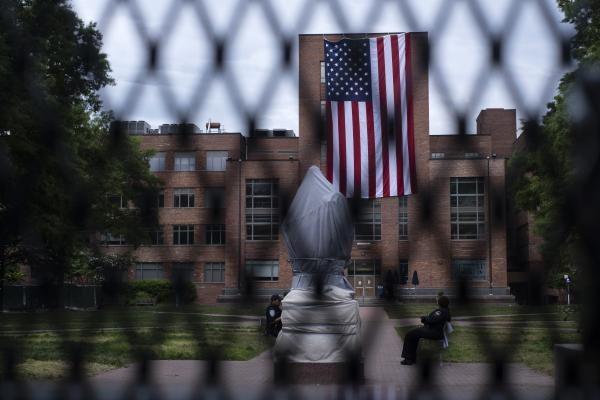
Join Senior Fellow Michael Sobolik for a conversation with Sarah McLaughlin, a senior scholar at the Foundation for Individual Rights and Expression, about her recent book on this subject, Authoritarians in the Academy.
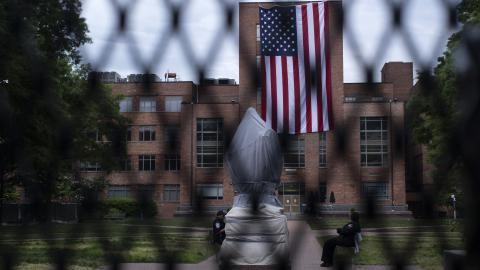

To discuss the future of Latvian foreign policy, Peter Rough will welcome Latvian Minister of Foreign Affairs Baiba Braže back to Hudson for a fireside chat.
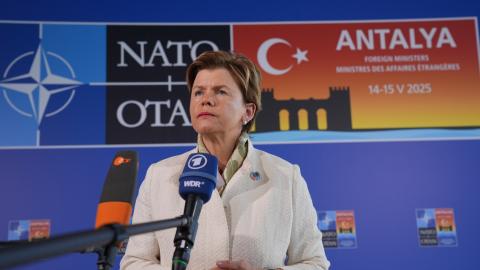

Hudson will host an exclusive luncheon conversation with Dina Kallay, deputy assistant attorney general for international, policy and appellate at the Antitrust Division of the US Department of Justice.

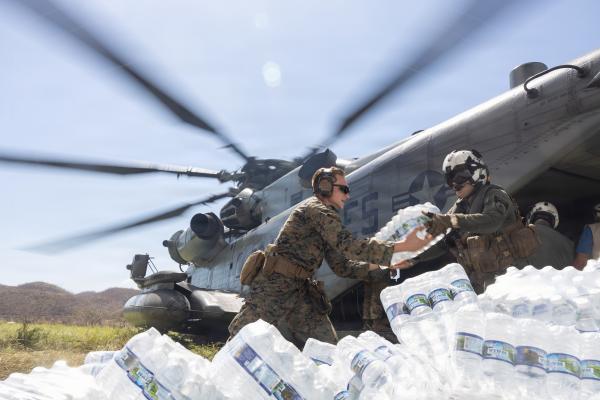
Moderated by Senior Fellow Matthew Boyse, a 35-year foreign service officer, this conversation will explore the evolving landscape of American diplomacy and development.
